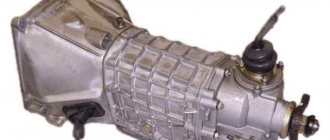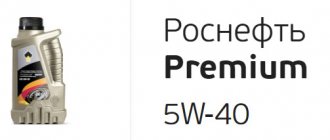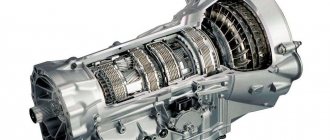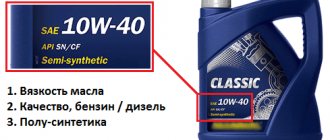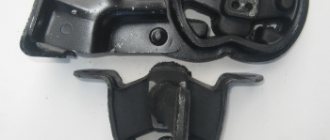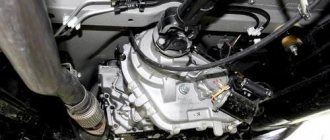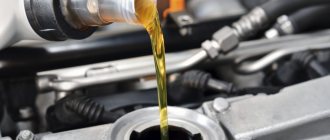When should you change?
According to the factory instructions, the service life of the oil in the VAZ 2110 gearbox is 75 thousand km. As practice shows, if a car is used in conditions of sudden temperature changes and in city traffic jams, then the frequency of oil changes should be reduced to 35-40 thousand km.
In addition to the scheduled oil change, there may be situations when the fluid should be changed immediately. A signal for an urgent oil change is the presence of metal dust or particles in the oil on the dipstick rod or noticeable thickening of the oil, not associated with its low temperature.
What is the difference between motor oil and transmission oil?
These two products work under completely different conditions and have different compositions and characteristics. They can be made from mineral raw materials, semi-synthetic materials and completely synthetic ones. They also differ in the amount and type of additives added to their composition to improve properties. The choice of additives depends entirely on the conditions in which they operate.
The conditions in which motor oils have to work are much more difficult than for greases or transmission fluids. For motor lubricants, the operating mode can be described as “ragged”. They are subject to a high degree of heating and a large number of temperature and pressure changes. They are exposed to chemical reactions from various gases, residues of fuel combustion products, and small amounts of gasoline or diesel fuel that may enter its composition.
Such complex and severe conditions should not affect lubricants, since they must provide for a long time:
- Serve as a seal between the cylinder, pistons and rings;
- Protect parts as much as possible from corrosion;
- Ensure heat removal from the friction zone.
Read the article for more details”
Which oil is better to choose?
The factory instructions allow the use of oils that meet API standards - SG, SH, SJ. Depending on these parameters, the behavior of the oil in winter, at fairly low temperatures, differs. The lower the initial viscosity parameters, the lower the temperature the oil will withstand. For the winter, many owners of VAZ 2110 with an injector fill in standard 75W-90 oil.
- Valvoline Durablend 75W-90;
- BP Energear HT 75W-90;
- TNK Trans KP 75W-90;
- Lukoil TM 4–12 80W-85;
- Lada Trans KP 80W-85.
All the oils listed above comply with the API GL4 standard. Currently, the most commonly used brands are Lukoil, ZIC, Mannol. The final choice of oil type remains with the car owner. Many reviews give preference to ZIC G-FF 75W-85 oil.
The manufacturer does not have any special requirements for the use of oil with GL4 or GL5 standards. The oil should not have a class lower than GL4, and the use of more expensive GL5 oil is possible and depends on the desire of the car owner. There are a number of opinions that GL5 oils contribute to more intensive wear of synchronizers.
Checking and changing the oil in the VAZ 2107 gearbox
Before removing the dipstick, it is recommended to clean it and the surrounding area from dirt. We carefully remove the dipstick, making sure that no dirt gets into the gearbox hole.
Then we find the gearbox drain plug (see photo)
Substituting a container to collect used oil, unscrew the plug with a “23” key
You need to wait a while for the oil to drain completely. Check the drain plug washer - if it is very worn, replace it. Screw the plug back into place. Next, you will need a special syringe for filling in clean oil, or a clean hose with a funnel. Depending on what gearbox oil filler you have, you may need to remove the air filter housing for ease of access. Fill the gearbox with oil (the photo shows pouring oil from a special syringe, with the filter housing removed)
After the oil has been added, wait a few minutes and check the oil level using the dipstick.
The level should be between the marks on the dipstick. If the level is lower, add oil; if the level is higher, pump out the excess (with a syringe, hose). Check if oil is leaking through the drain hole.
Level control and required volume
While operating the vehicle, it is necessary to regularly check the oil level in the gearbox. According to the factory instructions, control is carried out once every 15 thousand kilometers, but in practice it is advisable to carry out this operation 2-3 times more often.
To check the level, you need to remove the dipstick located on the top of the box housing next to the thermostat housing. There are two notches on the probe rod indicating the lower and upper limit levels. In a working box, the oil level should be slightly below the maximum level. If the level is insufficient, the oil must be added. To do this, fill in liquid from the same manufacturer and with the same parameters as before. If this information is unknown, then the oil must be changed.
When changing the lubricant, you need to know how much oil is in the VAZ 2110 box. According to factory standards, there are 3.5 liters of oil in the box. The oil volume does not depend on the number of valves on the engine, since the crankcase is the same. Therefore, to replace it, you need to buy a container with the same amount of new oil.
Sometimes, when filling, a little more than 3.5 liters enters the crankcase, but the level does not exceed the maximum permissible value. There is no need to pour more than 3.6 liters of oil into the box, as this causes increased resistance to gear rotation and increases fuel consumption. The second side effect of oil overflow can be squeezing out the wheel drive seals. It is better to pump out excess oil through the dipstick hole using a large-volume medical syringe equipped with a long tube.
Changing the gearbox oil
In a manual transmission, the oil should be changed every 90,000 km. , or after 7 years of operation. If the car is equipped with an automatic transmission, then the transmission fluid is replaced after 60,000 km, or after 6 years of use.
How much oil should be poured into the gearbox? Manual transmission volume - 2.8 liters Automatic transmission volume - 5.4 liters
What kind of oil should be poured into the gearbox? For a manual transmission - not lower than API GL-4, SAE 75W-85W or 75W-90 For an automatic transmission - ATF SP-III working fluid
Below we describe how to change the oil in a manual transmission; it is better to change it in an automatic transmission at a service center. Before replacing, it is recommended to drive the car a little so that the developed and warm oil drains better. We put the car on a pit or on a lift. We find the oil dipstick in the engine compartment, oil is poured through its hole. The dipstick has a visible yellow head, but due to adhering dirt, it can be overlooked. The access point to the probe is shown in the photo with a red dot.
DIY oil change instructions
The oil change procedure is very simple and does not require special knowledge or tools. Any car owner can do it with his own hands. Before starting work, it is necessary to warm up the car and gearbox by driving at least 15–20 km.
Required Tools
After warming up the box, you will need to prepare tools and consumables:
- an empty container with a capacity of at least 4 liters for draining used oil;
- key of any type with a size of 17 mm;
- rags;
- a funnel with a hose with a diameter of no more than 10-12 mm;
- canister with fresh oil.
Algorithm of actions
The procedure for changing the oil is as follows:
- Place the car on a horizontal pit or overpass.
- Remove the dipstick from the gearbox housing.
- If the engine and gearbox protection is installed below, it must be removed.
- Wipe the lower part of the crankcase with a rag and use a 17 mm wrench to unscrew the drain plug.
- Place the container and drain the oil. Complete draining of the oil takes at least 15 minutes.
- Wipe the plug and threads with a clean rag.
- Screw the plug in by hand and tighten it with a wrench.
- Install a hose with a funnel into the dipstick hole and fill in approximately 3.3 liters of fresh oil.
- Wait a few minutes for the oil to drain into the crankcase and check the level.
- If necessary, add oil or pump out excess.
- After 200-300 km, re-check the level and make sure there are no oil leaks through the drain plug or box seals.
Oil level dipstick on the top of the crankcase Drain plug on the bottom of the crankcase
Where to fill transmission oil?
Check the drain plug washer - if it is very worn, replace it. Screw the plug back into place. Next, you will need a special syringe for filling in clean oil, or a clean hose with a funnel. Depending on what gearbox oil filler you have, you may need to remove the air filter housing for ease of access. Fill the gearbox with oil (the photo shows pouring oil from a special syringe, with the filter housing removed)
After the oil has been added, wait a few minutes and check the oil level using the dipstick.
The level should be between the marks on the dipstick. If the level is lower, add oil; if the level is higher, pump out the excess (with a syringe, hose). Check if oil is leaking through the drain hole.
In this article we will tell you what kind of oil needs to be poured into the gearbox - in “mechanics” (manual transmission) and “automatic” (automatic transmission). What is the difference between gear oil?
Oil for manual transmission
Like motor oils, transmission oils have their own SAE quality levels and API viscosity grades and can be mineral, semi-synthetic or synthetic. The most common viscosity indexes are 75W; 80W; 90W; 110W. The smaller the number in front of the W index, the lower the temperature the oil can withstand before thickening in the cold. The most common manual transmission oil: 75W-90 is considered universal and suitable for most vehicles.
According to the API viscosity class, oils are marked with the letters GL and a number after the letters in the range from 1 to 5. The higher the number, the more detergent, anti-seize and anti-foaming properties are manifested in the oil. Therefore, oils of different viscosity classes are used in various vehicle components. Oils of classes GL1 to GL3 can be used in gearboxes of older cars.
Oils of the GL4 and GL5 classes are advanced.
What will happen if you don't change?
Failure to promptly change the oil in the gearbox significantly reduces the life of the unit. Transmission oils contain a whole range of additives that effectively remove corrosion products on steel gearbox parts and facilitate the operation of bronze synchronizers. Over time, these additives lose their properties and wear of parts increases with old oil. In addition, the oil serves to remove heat from gearbox components; the older the lubricant, the worse it provides heat removal. Metal particles generated during operation of the box will also have a negative effect. They will get into the bearings and contact spots of the gears, increasing their wear.
Replacement cost
The cost of replacement will only include the price of oil, which ranges from 1,200 rubles (Lukoil oil) to 2,700 (Valvoline). The most expensive oil options will cost up to 4 thousand rubles.
In order for the car to work properly, it is necessary to periodically perform certain preventive maintenance, scheduled repairs, replacement of consumables, and so on. Moreover, the frequency is indicated in the repair and operating manual for your car. A procedure such as changing the oil in a VAZ 2110 gearbox does not take much time and effort. This will take you about an hour, but you won’t have to hire specialists or pay them money for it.
According to the manual, on the “ten”, the oil in the VAZ 2110 gearbox should only be used as recommended by the manufacturer, and the frequency of the procedure is every 75 thousand kilometers traveled by the car. Although in some situations, when the machine is operated under increased loads, replacement is performed more often.
Changing the gearbox oil
In a manual transmission, the oil should be changed every 90,000 km. , or after 7 years of operation. If the car is equipped with an automatic transmission, then the transmission fluid is replaced after 60,000 km, or after 6 years of use.
How much oil should be poured into the gearbox? Manual transmission volume - 2.8 liters Automatic transmission volume - 5.4 liters
What kind of oil should be poured into the gearbox? For a manual transmission - not lower than API GL-4, SAE 75W-85W or 75W-90 For an automatic transmission - ATF SP-III working fluid
Below we describe how to change the oil in a manual transmission; it is better to change it in an automatic transmission at a service center. Before replacing, it is recommended to drive the car a little so that the developed and warm oil drains better. We put the car on a pit or on a lift. We find the oil dipstick in the engine compartment, oil is poured through its hole. The dipstick has a visible yellow head, but due to adhering dirt, it can be overlooked. The access point to the probe is shown in the photo with a red dot. Before removing the dipstick, it is recommended to clean it and the surrounding area from dirt. We carefully remove the dipstick, making sure that no dirt gets into the gearbox hole.
Then we find the gearbox drain plug (see photo)
Substituting a container to collect used oil, unscrew the plug with a “23” key
You need to wait a while for the oil to drain completely. Check the drain plug washer - if it is very worn, replace it. Screw the plug back into place. Next, you will need a special syringe for filling in clean oil, or a clean hose with a funnel.
Why do you need oil in the gearbox?
A relevant question for beginners that we must answer. There are several reasons why the transmission is an integral part of the transmission design.
- The gearbox consists of numerous mechanisms that are in motion, creating friction among themselves. To prevent parts from wearing out or grinding down, lubricant is used.
- When using oil, mechanical loads are significantly reduced, which leads to an extension of the service life of units.
- The transmission is capable of removing corrosion products and rust.
- Another important task is to reduce the temperature of structural elements during their operation. The gearbox does not overheat and operates in optimal mode due to cooling.
How to change the oil in a gearbox with your own hands
They are subject to strict requirements for anti-scuff and anti-wear properties. For modern cars, you should fill in transmission oil with a marking of at least GL4 (for new foreign cars - GL5).
Automatic transmission oil
Special oils are produced for automatic transmissions, which have special requirements for viscosity and foaming. The most important thing is foaming. This is due to the fact that if the oil foams heavily, the air bubble may block the control valve and any of the gears will stop engaging.
Automatic Transmission Fluids (ATF) - fluid for automatic transmissions. ATF has one feature - color. In order not to accidentally use them in conventional gearboxes, for which they are not intended in principle, they are specially painted in a noticeable color, most often red (they may be of a different color).
Unlike mechanical oils, automatic fluids do not have strict international standards. The world's leading automakers have developed their own requirements and classifications that ATF must comply with. For General Motors these are Dexron II, III and IV groups. The Ford company standards are designated as Mercon, the DaimlerChrysler concern - MB 236.1/236.5.
You should choose gearbox oil based on the technical documentation for the car. Note that on many machines, the transmission oil change period is equal to the service life of the unit itself. To be sure, it is better to change the oil in the box once every 4-5 years.
What else can you read?
TOP
Types of oils and their choice
Today there is a huge range of oils on the market that are designed for pouring into gearboxes. It’s not enough to just know how much of it is in the box of a VAZ 2110. You need to correctly select its composition.
The first thing you should pay attention to is the instruction manual.
for your model of the domestic automobile industry. It clearly indicates recommendations regarding what to put in the VAZ 2110 box.
There are three types of oils:
- Mineral;
- Synthetic;
- Semi-synthetic.
Many experts agree that specifically for the domestic “ten”, synthetics are best suited, allowing the vehicle to be operated under extreme loads and conditions.
But there is one caveat. High-quality synthetic oil is expensive, and not every car owner can afford such financial costs. But there are worthy alternatives among semi-synthetic gear oils.
Don't try to fool yourself and your car by creating a semi-synthetic transmission by mixing synthetic and mineral compounds. This is the dumbest thing you can do to your transmission. Such manipulations are unacceptable; they lead to unpredictable consequences.
Difference in oil types
Before finding out the consequences of mixing substances, it is necessary to understand the differences in the compositions and bases of liquids.
Engine oil
The product is manufactured for use at high temperatures, with the addition of high-tech additives.
The main indicators of fluids used in internal combustion engines are as follows.
- Minimum viscosity. Motor-type lubricants are designed to take into account high speeds and facilitate cranking of the crankshaft and drive units.
- High alkaline index. After fuel combustion, a large number of acidic compounds are formed. Alkaline additives neutralize the negative effects of acids on the engine.
- Detergent additives. During operation, the engine accumulates a large amount of burning and sludge deposits that require removal.
- High turnover. The composition guarantees the penetration of the formula into the smallest gaps of the moving parts of the engine, the sealing rings of the piston group.
- Manufacturers' approvals.
The parameters of motor lubricants are adjusted to the operating conditions of the internal combustion engine.
Transmission fluids are manufactured using a different principle. What is important here is the presence of a thick base and additive components that allow it to withstand high speeds and critical mechanical overloads.
- High viscosity. Gearbox lubricants are 10 times higher than internal combustion engine fluids. This is due to increased clearances relative to the engine design and the need to increase resistance to mechanical destruction.
- Low temperature stability. The gearbox does not produce temperatures comparable to those of an internal combustion engine. This eliminates the need for additives of this type.
Is it possible to mix engine and transmission oil? Taken together, the properties of motor and transmission lubricants are radically different. This indicates the impossibility of interchangeability of liquids.
Substitution rules
All owners of the “ten” must follow certain rules that will allow not only to correctly replace the oil in the gearbox, but also to extend the life of the gearbox and related units.
The rules are as follows:
- Oil is added to the transmission depending on the time of year. That is, in the warm season, summer is poured, in winter - winter, plus there are all-season compositions.
- Follow an important rule for preparing the transmission for changing the lubricant, which requires mandatory pre-warming of the vehicle.
- Use exclusively certified transmissions with a quality guarantee.
- Check the condition of the oil in the gearbox after every 10 thousand kilometers traveled.
- Optimal operating conditions for increasing the service life of the gearbox are smooth acceleration, the use of a standard braking system, as well as driving at a speed of 100-120 kilometers per hour (highways, highways, but not within the city).
- Use the correct gear shift pattern, do not overspeed, and depress the clutch pedal smoothly.
- If you cannot find the oil specified in the instruction manual, look for a composition that is as close as possible in terms of parameters. With the current range of transmission fluids, this is not a problem.
Mixing oils in the engine
There are two types of errors associated with internal combustion engines:
- filling the gearbox lubricant in full;
- adding lubricants in various proportions.
Both problems lead to a decrease in the effectiveness of the formula and complete destruction of the protective properties of the resulting composition.
It is worth examining each case separately.
If the substance is used for other purposes than its intended purpose, the following malfunctions occur.
- The lubricant spontaneously ignites when exposed to high temperatures. This provokes the release of soot and sedimentation. After foaming, the composition decomposes into its components, which causes the separation of solid flakes.
- Due to its high viscosity, the liquid does not guarantee retention of lubricating properties. Low fluidity prevents penetration between the piston rings and the smallest gaps. This provokes an increase in friction and overheating of the structure.
- When the substance foams, the units starve, filters and lines become clogged.
- Increased lubricant density negatively affects the condition of seals and oil seals. The liquid squeezes out the inserts, which causes leaks and depressurization of the system.
When adding lubricant to the engine, the following reaction occurs.
- When mixing incompatible bases, foam is formed, which precipitates on the surface of the components.
- Incompatible additives form hard deposits that clog the system channels.
- After complete blockage of the filter channels and highways, the effect of starvation of the moving parts occurs. The structure actively overheats, and scoring occurs.
- The final stage is complete failure of the power plant with destruction of components. The motor cannot be restored.
Market experts say the most critical point is the speed of reaction. Negative consequences after mixing engine and transmission oils appear after 100 - 200 km.
Nothing good happens when different types of lubricants are mixed in transmissions. Motor fluids are intended for other operating conditions. The composition is selected taking into account these parameters and is not intended for servicing the gearbox.
If you pour the mixture into a CVT or robotic automatic transmission, the substance clogs the channels and filters, which leads to a decrease in the friction indicator, overheating of the gears, and deformation of the crowns.
If you pour clean motor oil into the gearbox, the consequences will also be negative. Fluid of insufficient viscosity will drain from the teeth, not providing optimal lubrication. A high alkaline index has a negative effect on smooth coatings. Active alkalis can deform surfaces, which will lead to scoring and cracking of teeth.
Replacement procedure
Now let's talk specifically about how to change the oil in the gearbox of a VAZ 2110. The procedure is not difficult even for doing it yourself. Follow certain rules, act competently and confidently.
First, stock up on the necessary tools and auxiliary things. You will need:
- 17mm wrench;
- Syringe for filling the transmission. It will make filling much easier;
- Container for draining used transmission oil.
Let's get to work. It consists in the sequential execution of several stages.
- Warm up the car for a while, then lift it on a lift or drive it into a hole so that you have access to the bottom.
- Remove the mudguards from the engine.
- Using a 17 key, slightly loosen the plug that is mounted in the drain hole of the gearbox.
- Unscrew the plug completely and drain the used transmission fluid into a container prepared in advance.
- Be sure to clean the plug, remove all dirt and debris accumulated on it. After this, you can put it in its rightful place and screw it tightly.
- Clean the waste that you drained from your gearbox of mechanical impurities. This is all kinds of dirt, sediment, and so on.
- Flush the transmission according to the owner's manual. It clearly states exactly how the gearbox is washed.
- If the transmission fluid level indicator is dirty, clean it. This will ensure that the correct amount of liquid is added.
- Fill the gearbox with new oil that meets all the parameters of the VAZ 2110. If you have problems with the required volume, that is, you don’t know how much oil you need, then we will help you. For the domestic “ten” it requires 3.3 liters of transmission fluid. Filling is done with a syringe.
- Use the dipstick to check whether you have filled enough oil into the gearbox housing.
- Reinstall the mudguard according to the instructions.
- Check the operation of the car with new transmission fluid. If the oil is correct, the machine will work normally, you will not notice any signs of malfunction.
. Asks
: Kirilichev Konstantin.
The essence of the question
: What oil is best to pour into the VAZ-2112 gearbox, am I going to change it completely?
Good afternoon Please tell me what oil is best to fill in the VAZ-2112 gearbox? I have never changed it, and my mileage is already more than 100 thousand kilometers. I would like to know which manufacturer and other technical parameters are best suited for my car?
Changing the gearbox oil
In a manual transmission, the oil should be changed every 90,000 km.
, or after 7 years of operation. If the car is equipped with an automatic transmission, then the transmission fluid is replaced after 60,000 km, or after 6 years of use. How much oil should be poured into the gearbox? Manual transmission volume - 2.8 liters Automatic transmission volume - 5.4 liters
What kind of oil should be poured into the gearbox? For a manual transmission - not lower than API GL-4, SAE 75W-85W or 75W-90 For an automatic transmission - ATF SP-III working fluid
Below we describe how to change the oil in a manual transmission; it is better to change it in an automatic transmission at a service center. Before replacing, it is recommended to drive the car a little so that the developed and warm oil drains better. We put the car on a pit or on a lift. We find the oil dipstick in the engine compartment, oil is poured through its hole. The dipstick has a visible yellow head, but due to adhering dirt, it can be overlooked. The access point to the probe is shown in the photo with a red dot. Before removing the dipstick, it is recommended to clean it and the surrounding area from dirt. We carefully remove the dipstick, making sure that no dirt gets into the gearbox hole.
Then we find the gearbox drain plug (see photo)
Substituting a container to collect used oil, unscrew the plug with a “23” key
You need to wait a while for the oil to drain completely.
How to choose the right gearbox oil?
Today, the situation on the gear oil market looks like such that most of the products presented consist of all-season components capable of stable operation at any time of the year. Therefore, the choice of most car enthusiasts, in the erroneous opinion, consists only of choosing a company, which, as a rule, is well-established and widely known in the market.
The following two tabs change content below.
All my life I have been surrounded by cars! First, in the village, already in the first grade, I was rushing around on a tractor through the fields, then there was JAVA, then a penny. Now I am a third-year student at the Polytechnic Faculty of Automotive Engineering. I work part-time as a car mechanic and help repair cars for all my friends.
There are some nuances in choosing transmission oil for the VAZ-2112
, which we will tell you about in detail below.
What kind of oil should I use?
Checking the oil level after filling a new one
The most important criterion that should be adhered to when purchasing gear oil is the manufacturer company that best protects its products from counterfeit analogues
, and the factory recommendation for choosing engine oil, because it contains complete information on the standards for such liquids.
Advice!
Buy transmission oils only from trusted sellers, in specialized stores, because choosing “tent” products and chasing cheap analogues can negatively affect the condition of the entire transmission as a whole.
What to choose?
Among the transmission oils of the VAZ family, three categories can be noted:
- GL-4
- The oil is suitable for all gearboxes of front-wheel drive VAZ models, has an API classification and is very popular among VAZ-2112 owners. - GL-5
– intended for other VAZs, including representatives of the “classics”. - GL-4/5
is a universal oil that sits in the middle between the first two types.
Now let's talk in detail about what is better: synthetic, mineral or semi-synthetic oil?
Leakage from the gearbox seal after filling synthetic oil into the gearbox
It has long been known that a semi-synthetic analogue
, has many more advantages when used on a car with a mileage of more than 100 thousand kilometers.
Because it is less viscous, there will be significantly less leakage from microcracks in the gaskets. High lubricating properties, and a wide range of operation at different temperatures, since the temperature in summer and winter in most cities of our country is significantly different. And another plus is that it costs much less than synthetic, and the quality is much better than mineral.
Do-it-yourself gearbox oil change
If you plan to change the oil in the gearbox yourself, then you need to be very careful where this procedure is described in great detail.
Any unit with rotating parts requires lubrication. And in the case of a variable gearbox, the lubricant must also be of proper quality. Which oil is better to buy for the transmission of a VAZ 2109? Light on this issue is shed by these instructions for choosing oil for a VAZ 2109 gearbox. Study this article carefully - here you can learn about the choice between engine and transmission oil, synthetic and semi-synthetic, as well as the choice between different manufacturers of transmission oils. Photos and videos will help you understand this difficult issue more thoroughly. So, let's begin.
- Oil options for VAZ 2109 gearbox
- Engine oil
- Transmission oil
- Manufacturer's choice
- Domestic manufacturers
- Foreign manufacturers
- Some tips for filling oil
- Conclusion
Engine oil in manual transmission
Let us immediately note that if we are talking about automatic hydromechanical transmissions (automatic transmission or variator), in this case it is better to immediately abandon attempts to fill in engine oil, even in the event of a critical drop in the fluid level in the transmission due to various malfunctions.
As for manual transmissions and robotic gearboxes, in this case the use of motor oil at first glance may seem quite possible. Moreover, on some auto forums there is information that car enthusiasts are actively experimenting by using engine oil in the gearbox, pouring Dexron into the manual transmission, etc.
- So, first of all, the manufacturers themselves separately produce motor and transmission oils. At the same time, the characteristics of various lubricating fluids from both groups differ markedly.
Transmission and engine oils differ in viscosity index and also have different additive packages that provide the properties necessary for normal operation of the units. However, many owners of front-wheel drive cars, rear-wheel drive VAZ classics and old foreign cars claim that using internal combustion engine oil in a manual transmission can be done without any consequences.
You also need to take into account that the transmission structure itself may differ in different cars. This means that while the use of motor oil in a VAZ gearbox may not lead to obvious problems, the same cannot be said about foreign cars, even relatively old ones.
- Let's move on. If we consider the issue of characteristics, we need to consider how gear oil differs from motor oil. Even taking into account the fact that the base may be the same (mineral oil, synthetic or semi-synthetic), the amount and types of additives in the composition are very different.
It is quite obvious that lubricating fluids are developed taking into account the conditions in which they will need to work. At the same time, motor oil requires operation under more severe conditions than transmission fluids and other lubricants.
However, even under such conditions, throughout its entire service life, the lubricant in the engine must effectively protect loaded friction pairs, remove heat, wash away and retain wear products, protect parts from corrosion, etc.
- As for transmission oils, first of all, they need to be changed less frequently than motor oils. In “mechanics”, the oil is changed every 60-80 thousand km; in the case of an automatic transmission, even in difficult operating conditions, replacement is necessary every 40 thousand km.
Let us also add that, regardless of the type of gearbox, the lubricant in the transmission must ensure minimal wear between friction pairs using a “dense” and persistent oil film; at the same time, it is necessary to reduce friction losses of gear pairs, reduce noise during operation of the unit, prevent corrosion, wash off and retain wear products, etc. To obtain such qualities and properties, special additives are used that differ from those found in motor oils.
Is it possible to add engine oil to a manual transmission?
Taking into account the above information, it becomes clear that although some characteristics and properties of lubricants for the engine and transmission are similar, these oils still belong to different groups. At the same time, on some front-wheel drive car models, the use of engine oil in the gearbox is acceptable, but such use should be short-term. Moreover, the service life of the unit may be reduced by at least a third.
We will also add that if it is necessary to add oil to the gearbox in an emergency, you can use motor oil instead of gear oils. It is important to understand that this is a last resort measure. With such a mixture in the box, you can only get to the repair site, and not operate the car.
Finally, we note that if the gearbox is completely or partially filled with engine oil for one reason or another, all fluid from the gearbox must be drained in full as soon as possible. Next, the oil in the gearbox is replaced with one recommended by the car manufacturer itself.
Choosing oil for a manual transmission: types of gear oils, features and differences. What kind of oil is best to fill in a manual transmission, what needs to be taken into account.
Is it possible to mix oils in a gearbox: what you need to know, the possible consequences of mixing gear oils for a gearbox. Useful tips.
How to change gear oil in a gearbox: changing oil in manual and automatic transmissions. When to change the oil in automatic and manual transmissions. Useful tips.
Checking the oil level in an automatic transmission: how to check the ATF level. What else to pay attention to: color, smell, ATP contamination, etc.
Why does engine oil start to drip or leak at the junction of the engine and gearbox. How to accurately determine the cause of a lubricant leak, methods of diagnosis and repair.
How to change gear oil in a Lada Largus gearbox. Procedure for replacement, selection of oil at the Largus checkpoint. Tips and tricks.
Oil options for VAZ 2109 gearbox
Oil requires careful selection. So what are the options - what to choose from? So:
- When front-wheel drive cars appeared, owners tried two options. The first was the same as for the “classics”, that is, transmission oil TAD-17, but experience has shown that such oil is not suitable for the nine. And all because the main pair in the nine gearbox is helical, and not hypoid, as on the classic.
- The second option is regular motor oil. That's where we stopped at that time. This option will be discussed in more detail later.
- Now there are many other options for oil for filling in the VAZ 2109 gearbox.
- Domestic oils
- Foreign oils
- Various classifications (GL-4, GL-5 and TM-4, TM-5)
- Various viscosities (SAE 80, SAE 90)
- Mineral, semi- and synthetic oils
Advice! As you can see, the choice is large, and the correct choice is usually one or two. Take your time, but carefully study the theory before you start changing the VAZ 2109 oil.
The choice of oil for each car is different
This applies not only to different car brands. Even for different VAZ 2109 vehicles, completely different transmission oil options may be suitable. Let's figure out which oil is best to use in which case.
Engine oil
So:
- What are the benefits of using motor oil in transmissions? The first thing that comes to mind is its price, which is within acceptable limits.
- Analyzing reviews from owners of 2109, you can notice some features. For example, there are a number of cases when a car drove 300-400 thousand kilometers on motor oil poured into the gearbox without the slightest claim for repairs.
- On the other hand, other cases show that the use of engine oil is undesirable, since it leads to rapid wear of gearbox parts, such as synchronizers or gears.
- So how can you determine whether the engine oil is suitable for the gearbox of a VAZ 2109? Again, analyzing the overall picture of the use of such oil, we draw a simple and very important conclusion.
Conclusion! Engine oil can only be filled in if the vehicle is manufactured before 1993-1995. For cars produced in later years, the use of engine oil in the transmission is highly discouraged.
Transmission oil
There are a great variety of such oils and there is not enough time and patience to consider all specific oils. Therefore, we will consider only categories of oils, and in some cases we will give examples. Go:
- Let us mention the TAD-17 in a little more detail. If anyone doubts that it cannot be used in the VAZ 2109, read below the reasons for this.
- The viscosity or thickness of TAD-17 oil is very high, which leads to the following problems: the car will not start in winter; extreme pressure additives (which in themselves give a good effect) are contained in very large quantities in the oil.
- A large amount of extreme pressure additives contributes to intensive wear of synchronizers.
- Synthetic oil, it would seem, should be better than others. It is better in thickness, has positive qualities, and has additives. But there is one thing! The use of synthetic gear oil (designated GL-5 or TM-5) is encouraged in sports gearboxes, where the quality of the parts is better, the temperature is higher, and (in some cases) there are no synchronizers.
By the way! By carefully reading the instructions for the transmission oil, you can determine whether it is suitable for your car or not.
- So, in the instructions for GL-5 class synthetic oil it is directly written: “used for unsynchronized manual transmissions.”
- And one more point not in favor of synthetics is its price. The cost of such oil is high, and practicality is not very good - therefore, the use of synthetic oil in VAZ 2109 gearboxes does not make sense.
- And the last option is semi-synthetic gear oil. It is perfectly suited for use in this car.
- The designation of this oil is GL-4.
By the way! The service book for the car indicates the type of oil recommended by the manufacturer. This is exactly GL-4 or TM-4.
- In terms of density, it is better to take the designation 75 or 85. The composition of this oil and its properties are optimal for both gearbox gears and its synchronizers.
- As for the winter period, semi-synthetics will not freeze as much as mineral water, for example. In frosty weather of -25 degrees the car will start, just like in summer.
Is it possible to pour motor oil into the gearbox?
We previously discussed that transmission and engine oils operate under very different conditions. Accordingly, the properties of liquids of these two groups are very different. Motor oil, although it performs in harsher conditions, is not designed to withstand the loads and temperatures that transmission fluids must endure.
Differences in the chemical composition and additive packages do not allow us to predict how engine oil will behave when added to the gearbox or how the additive package will work in conditions for which it is not designed.
For cars with classic layouts, for example, even if a different type of transmission oil is poured instead of the recommended one, the unit may need to be repaired after just a few thousand kilometers.
Thus, we answer the question - is it possible to pour engine oil into the box? In general, this should absolutely not be done!
However, there are some exceptions to this rule.
- For some models of front-wheel drive vehicles, manufacturers allow the possibility of short-term use of motor oils in gearboxes, warning that the service life in this case is reduced by up to 30%.
- There is a group of universal products that are used as motor, transmission, and hydraulic fluids. However, these materials are used only in special equipment and are not applicable for ordinary vehicles.
- Some automakers, including Honda, Peugeot and Chrysler, allow motor oils to be poured into the box for some of their models.
- A historically well-known example is that in the USSR, in the first Zhiguli models, engine oil was poured into the gearbox at the factory. The design features of cars of those times made it possible to do this without much damage to the car. However, this decision was most likely caused by a lack of special transmission fluids.
Manufacturer's choice
We have already listed the brief characteristics, and now you can delve into the choice of oil manufacturer for the Samara gearbox. So, who does the best on the VAZ 2109?
Domestic manufacturers
So:
- The gearbox oil declared by the plant is TM-4-12. Ideally, you should use it, of course. This oil was specially developed for the gearbox of this particular vehicle.
- Using logic, we come to the conclusion that since it was specially developed, it must be the best. The manufacturer may be different - for example, Rexol.
- For example, the M6z12G1 engine oil used in the VAZ 2109 gearbox falls slightly short of the TM indicators.
- LukOil SAE 15W-40 is also a good competitor to specially developed oil, TM-4-12. The gap from it is only 4%.
Foreign manufacturers
We analyze the oil for the foreign-made VAZ 2109 gearbox:
- The Castrol brand, and more specifically EP-80 and EP-90 oil, which according to the GL-4 class is undesirable for use in Samara gearboxes. Its properties are more suitable for sports gearboxes.
- But the foreign company Valvoline, which produced DuraBlend SAE 75W-90 oil, distinguished itself with good performance for our car. This semi-synthetic oil is in second place, after the recommended domestic oil TM-4-12.
- On the other hand, the same Valvoline, but no longer GL-4, and GL-4/5 is not suitable for high-quality operation of the VAZ 2109 gearbox.
We remember that the presence of extreme pressure additives has a positive effect on the overall performance of the gearbox. However, too much of them contributes to rapid corrosion of metals. This is because extreme pressure additives include sulfur, which corrodes gears.
- From this point of view, motor oils are the best contenders (but we also remember about their other qualities).
- And again, semi-synthetic Valvoline turns out to be close to the standard - TM-4-12. But synthetic, on the contrary, turns out to be the most destructive in this regard.
As for other manufacturers, it is worth paying attention to some points and studying the composition of the oil in detail. Pay attention to:
- Viscosity
- Oil operating temperature – pour point
- Number of additives and their type
The vehicle transmission, like the power plant, cannot be operated without lubrication. Not only the performance of parts and their normal functioning, but also the overhaul life of the products depends on its quality composition. An effective means of maintaining a vehicle in good condition is to periodically monitor the level of lubricant in the gearbox and replace it as necessary.
How to correctly determine which oil should be poured into a VAZ 2110 transmission type box in order to operate the “ten” for a long time and successfully?
A few words about gear oils
Such materials are used in manual and automatic transmissions, transfer cases, differentials and steering systems. In these units, the torque is transmitted by pairs of gears of the gear type. Any elements of such a system in mechanical devices are lubricated by being in oil, or by supplying it to the working elements.
Oils of this type are replaced every 60-70 thousand km. Periodic changes of such fuels and lubricants have a beneficial effect on the performance properties of the vehicle.
Transmission oil in the VAZ 2110 gearbox has the following functionality:
- Protects the working surfaces of parts from the effects of increased friction, thereby reducing losses due to excessive metal-to-metal resistance.
- Control over the correct operation of contacting working surfaces using thermal lubrication functions.
- Protects transmission elements from impact loads, protects the car from excessive vibration and various noises.
- It has a protective effect on gearbox elements from corrosion and removes wear products from stress zones.
In a VAZ 2110 car, the oil in the gearbox must maintain an initially high degree of viscosity at operating temperatures from 80 to 120°C and further up to 200°C. This is due to an increase in temperature conditions at the points of interaction of gear drives. On the other hand, the excessive viscosity of such lubricants at subzero temperatures will interfere with the normal movement of the gear transmission.
Requirements for gear oils:
- ability to counteract oxidative processes;
- excellent anti-wear qualities;
- good ability to resist corrosion;
- counteraction to foaming processes.
The characteristics of transmission oils in terms of viscosity and temperature are determined according to the international SAE classifier and are divided into 4 winter (with the letter W) and 3 summer types.
Transmission oils in automatic transmissions have slightly different functions, because in hydromechanical systems, like an automatic transmission, the oil serves as the working fluid. Such lubricants, taking into account the above requirements, must have an anti-friction effect.
In addition, the requirements for the viscosity of fuels and lubricants are increasing, because the automatic transmission contains a large number of components and parts that perform a wide range of functions: a torque converter, automatic transmission gears, a control complex where friction pairs made of various materials work: steel, cermets, bronze, etc.
In addition, such units are subject to aeration due to high-speed oil flows, which is a prerequisite for the appearance of foam. This is fraught with accelerated oxidation and corrosion of automatic transmission materials.
Changing the oil in “mechanics” “tens”
Procedure for changing oil in manual transmission:
- It is better to replace the lubricant immediately after operating the vehicle, when all units maintain operating temperature conditions.
- We place the car on a level area, set the parking brake and turn off the power to the vehicle.
- For convenience, we place the “front” of the car on a stand. Check the oil level with the vehicle standing horizontally.
- Clean the filler plug and inspection hole.
- Place an oil drain tank under the gearbox housing and unscrew the plug. Take measures to prevent burns from hot aggregate oil.
- After draining the waste, thoroughly clean the hole plugs, paying special attention to removing metal particles from the inserts with magnets.
- Wait until the oil has completely drained and place the car in a horizontal position.
- Fill the unit with oil and test the lubrication level in the unit. Tighten the inspection plug, take a short trip and check the oil level in the gearbox, and if necessary, add the missing amount. Tighten the plug with the recommended torque.
Changing the gearbox oil
Depending on what gearbox oil filler you have, you may need to remove the air filter housing for ease of access. Fill the gearbox with oil (the photo shows pouring oil from a special
syringe, with the filter housing removed)
After the oil has been added, wait a few minutes and check the oil level using the dipstick.
The level should be between the marks on the dipstick. If the level is lower, add oil; if the level is higher, pump out the excess (with a syringe, hose). Check if oil is leaking through the drain hole.
Changing the oil in an automatic VAZ 2110
Filling the VAZ 2110 automatic transmission with oil is required every 30,000 km. after the next replacement. In this case, it is also possible to change the lubricant earlier if there is extraneous noise and crunching in the automatic transmission.
According to the recommendation of the car manufacturer, it is recommended to fill this model with GL-4 oil according to API tariff. Thus, shell oil 75W90 is one of these recommendations from the manufacturer. It is better to carry out the procedure at a service station, where professional specialists will quickly and efficiently carry out all the work.
Is it possible to put motor oil in the box?
Motor oil is quite different from ATF fluids.
- Inappropriate temperature conditions. Automatic transmission fluids, even in severe frosts, maintain acceptable fluidity relative to motor oils. Relatively speaking, if the oil thickens to the consistency of, for example, honey, then the hydraulics (starting from the torque converter, pumping through the hydraulic plate) will be partially or completely paralyzed. Although there are winter oils that remain quite liquid even at very low temperatures (0W standard). So this point is very conditional.
- Unpredictable operation under high pressures. One of the prerequisites for normal operation of an automatic transmission is the predictability of oil behavior under pressure. An automatic transmission is a complex mechanism consisting of an extensive system of hydraulic channels. Each channel has its own strictly standardized values of pressure and flow rate. The liquid must not only be incompressible and transmit force well, but also in no case form air pockets.
- An unsuitable additive package that will damage the box. The only question is how long it will take for the consequences to appear. The mechanical part in an automatic transmission operates with high contact loads, which engine oil cannot cope with at its peak. Scouring and chipping of teeth is a matter of time. And rich engine oil additives, which are designed for 10-15 thousand kilometers in the engine (and in completely different conditions than in automatic transmissions), can precipitate. Deposits in the valve body will certainly cause problems.
In general, pouring engine oil into an automatic transmission can only be done as a sophisticated and expensive experiment: how long will an automatic transmission last on engine oil. Even the most expensive and technologically advanced motor oil is not suitable for normal operation in an automatic transmission.
Transmission seals
VAZ 2110 gearbox seals are replaceable components in the transmission of this car. There are the following types of repair work when maintaining the gearbox for a VAZ 2110 car:
- replacement of gearbox seals located on front wheel drives;
- replacing the gearbox seal on the unit’s input shaft;
- Replacing the cuff of the speed selection system rod.
All this work is best carried out under the supervision of an experienced assembly fitter, who can help with practical advice if necessary.

